Here it is…
 Well, it arrived! After months of consideration after I got my X-E1 I finally decided to send off the X Pro 1 for Infrared conversion. It went to Dan at LDP (maxmax.com) and the cost was $500.00. YIKES! yes I said $500.00! Dan explains that the X Pro 1 is the most difficult conversion that he does! It required him 1.5 days to do the conversion and lots unsoldering/soldering to get to the sensor. Still, better than sitting on the shelf or an attempted sale on Ebay, plus I really like the camera and the hybrid viewfinder is just perfect for IR.
Well, it arrived! After months of consideration after I got my X-E1 I finally decided to send off the X Pro 1 for Infrared conversion. It went to Dan at LDP (maxmax.com) and the cost was $500.00. YIKES! yes I said $500.00! Dan explains that the X Pro 1 is the most difficult conversion that he does! It required him 1.5 days to do the conversion and lots unsoldering/soldering to get to the sensor. Still, better than sitting on the shelf or an attempted sale on Ebay, plus I really like the camera and the hybrid viewfinder is just perfect for IR.
I had to decide between 720nm and 850nm so decided to go for the 720 in order to have a little color ( I really like the bronze tones right out of the camera at 720nm). The total time for shipping – conversion – shipping was 8 days, door to door. Very fast!
Importantly, the Fuji X Pro 1 camera White Balances perfectly. For these tests I white balanced on a green shrub in front of my gallery. The process to do so on the camera is simple and fast!
The scope of THIS post is to talk about the conversion itself and to give you some sample images testing each of my normal Fuji and Voigtlander lens set that I use.
- Voigtlander Heliar 75mm f/1.8 Lens
- Voigtlander Ultra Wide-Heliar 12mm f/5.6
- Fujifilm XF 35mm F1.4 Lens
- Fujifilm XF 18-55mm F2.8-4.0 Lens Zoom Lens
- Fujifilm XF 18mm F2.0 Lens
- Fujifilm XF 60mm F2.4 Macro Lens
My first image out of the camera was with the Fujifilm XF 35mm F1.4 Lens. It is stunningly sharp with great contrasts and tones without any processing at all! This is simply a perfect IR image right out of the camera.

Fuji X Pro 1, Brookgreen Gardens, 720nm RAW un-processed. Fuji X 35mm lens.
OK, the original hot mirror can tell us a lot about the capability of the Fuji body to take IR with no conversion. The strength of the internal filter from the X Pro 1 is quite strong! It is actually 2 filters sandwiched together. They are very much like the B+W 486 IR blocking filter and the LDP CC1 IR blocking filter back to back. The 486 is a pink/gold filter that extends a little further into the visible light spectrum before falling off and allows a little less IR to pass through. The CC1 filter is wider at the UV end. The two filters together will pass light to the sensor from about 300nm to 700nm. You can see this in the image below. This is the same filter arrangement (hot mirror) that we normally see in the Canon DSLR line and on the Panasonic Micro 4/3 camera line.
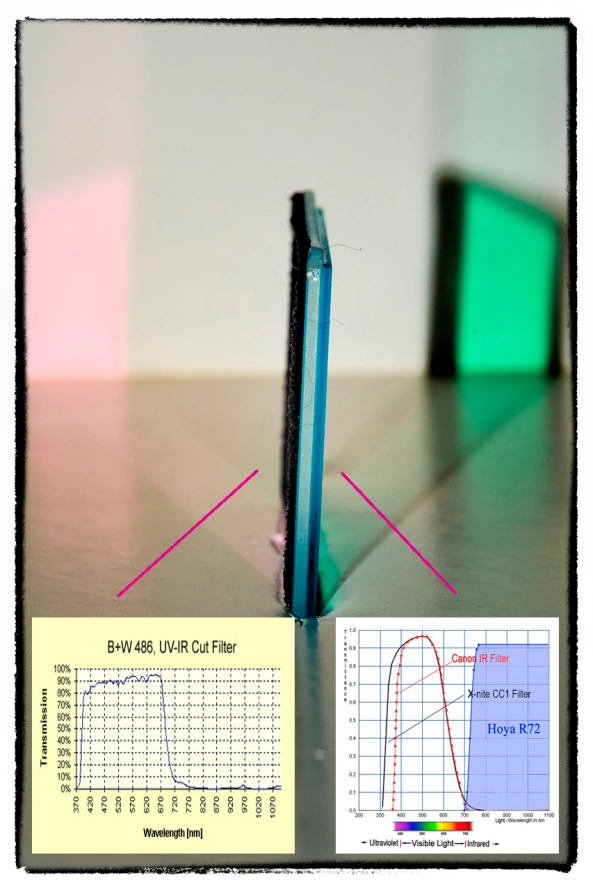
X Pro 1 Hot Mirror showing both Wide bandpass side (gold tint) and the Lower UV side (Aqua)
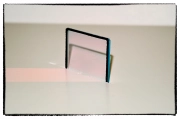
X Pro 1 Hot Mirror showing the Wider bandpass side (gold tint)
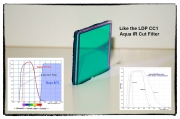
X Pro 1 Hot Mirror showing the Lower UV side (Aqua) similar to the CC1 filter from LDP
If you were to look at the 486 and CC1 filters they are the same general colors and pass band to what we actually see here! So , what does this all mean to you? If you decide (and convince Dan) to have a full spectrum conversion done on your X Pro 1, you can convert it back to a normal color camera by stacking both of these filters (B+W486 and the LDP CC1) on the end of your lens. The full spectrum Infrared conversion is one where the hot mirror (IR blocking filter) is removed from in front of the sensor and replaced with a piece of clear glass. Then, the camera is programmed to the specific UV or IR band with the addition of the appropriate filter on the end of the lens.
Normally, the hot mirror can bee seen as the colored layer of glass under the lens as shown here where you can now see the 720nm filter installed.

Inside the X Pro 1 showing the 720nm filter.
Lenses that Work/Don’t Work with the X Pro 1 720nm IR conversion…
Lens Hot Spots
As you may know (or guessed), not all lenses work well in the Infrared spectrum. This is due to many things, but most commonly, the coatings on the lens elements and the coatings on the internal lens barrel and how they reflect IR light energy. The common failure then is in the form of HOT SPOTS in the center of the image captured by the camera. These are always dead center in the middle of the image and present as large round white areas. Sometimes, they can be overcome by using a wider aperture, but not always…
Lets talk about the lenses that I tested that work (or in 1 case mostly work)…
Fujifilm XF 35mm F1.4 Len:
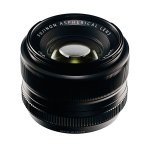
Fuji X 35mm Lens
WOW, what can I say? This lens works perfectly in the 720nm spectrum at all apertures! The camera auto focuses perfectly and fast, the images are sharp and there are no hot spots at any aperture! Lets take a look. This first image is raw out of the camera. I have done not post processing for B&W or Faux Color but there is enough color in the 720nm spectrum to have some interesting Faux Color results. These types of images will be covered in another post next week and we will spend a lot of time and effort teaching and going through each step in the recipe used to create them in Photoshop CS6 and the Nik filter set.

Fuji X Pro 1, Brookgreen Gardens, 720nm RAW un-processed. Fuji X 35mm lens f/8
Next, is the same image post processed using CS6 and Nik’s Silver EFX Pro for B&W…
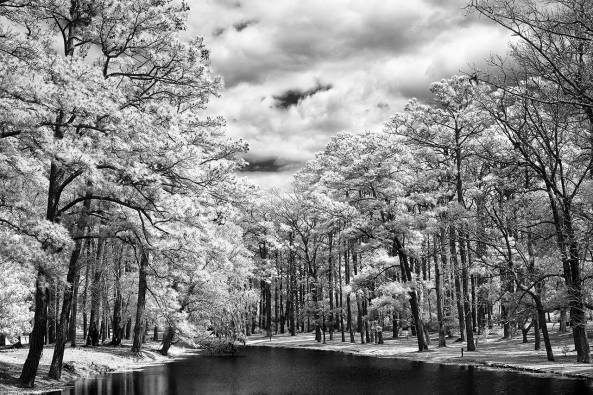
Fuji X Pro 1, Brookgreen Gardens, 720nm B&W processed. Fuji X 35mm lens f/8
Voigtlander Heliar 75mm f/1.8 Lens:
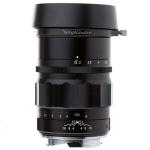 This lens from Voigtlander is one of the sharpest, easy to use lenses that I own. The fit and finish on this lens is something to behold. The lens has an included clamp on lens hood that works very well. The focusing is so smooth that it is scary… It is a PERFECT match for the Fuji X system (X Pro 1 and the X-E1) and works just as well here in Infrared! I was very happy to discover this in my tests at 720nm! There are no hot spots at any aperture. It takes Take a look:
This lens from Voigtlander is one of the sharpest, easy to use lenses that I own. The fit and finish on this lens is something to behold. The lens has an included clamp on lens hood that works very well. The focusing is so smooth that it is scary… It is a PERFECT match for the Fuji X system (X Pro 1 and the X-E1) and works just as well here in Infrared! I was very happy to discover this in my tests at 720nm! There are no hot spots at any aperture. It takes Take a look:
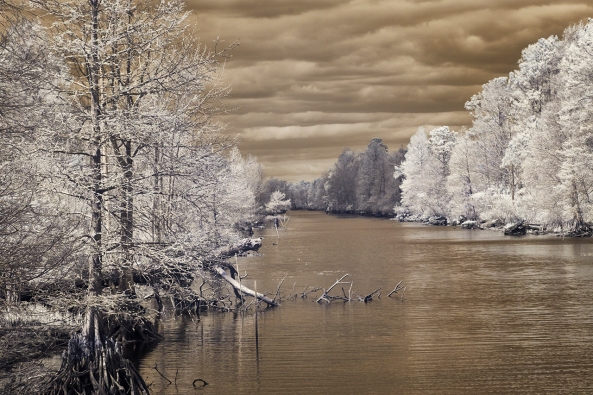
Voigtlander Heliar 75mm f/1.8 Lens at f/11. Raw (notice the nice bronze coloring)
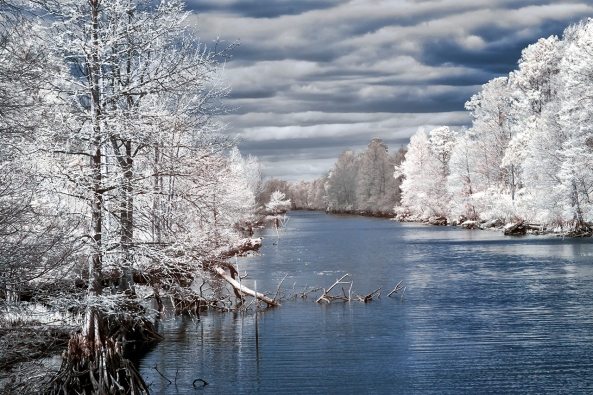
Voigtlander Heliar 75mm f/1.8 Lens, f/8 Faux Color Post Processing
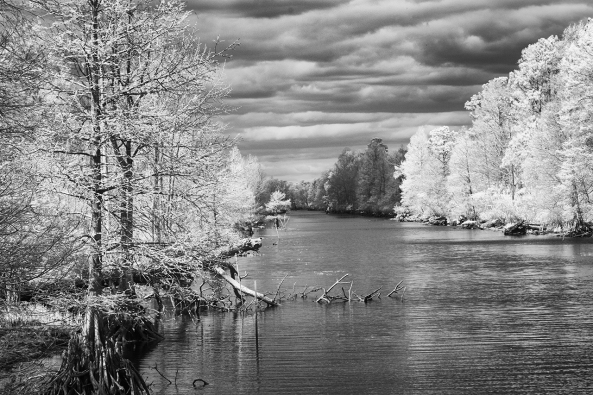
Voigtlander Heliar 75mm f/1.8 Lens, f/8 B&W Post Processing
Fujifilm XF 18mm F2.0 Lens:
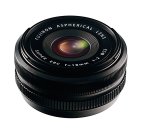
Fuji X 18mm lens.
This lens works well as long as you do not go beyond f/8. Past that it generates very discinct hot spot in the center of the image. While this can be overcome in post processing with Nik’s Viveza, it is still slightly disappointing… Still, when used at f/8 or wider the lens generates pleasing sharp images that make it worthwhile to carry in your camera bag! Here are the RAW test samples for you to consider.
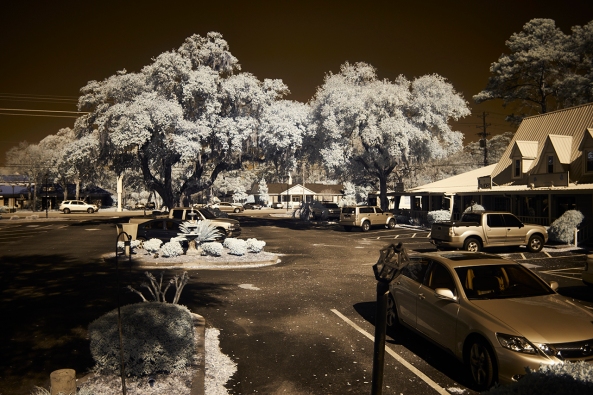
Fujifilm XF 18mm F2.0 Lens at f/2
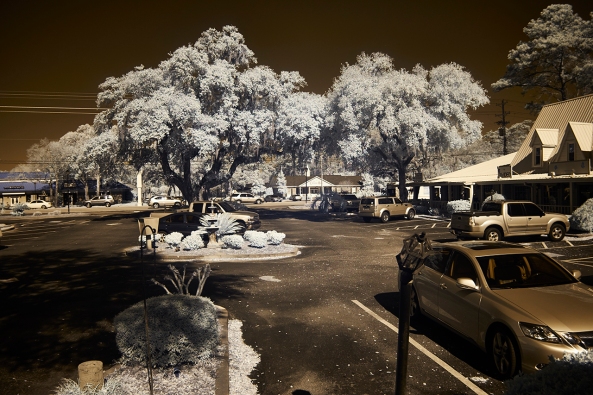
Fujifilm XF 18mm F2.0 Lens at f/4
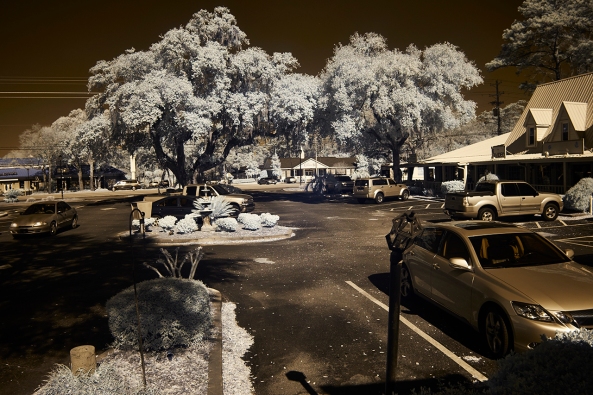
Fujifilm XF 18mm F2.0 Lens at f/5.6
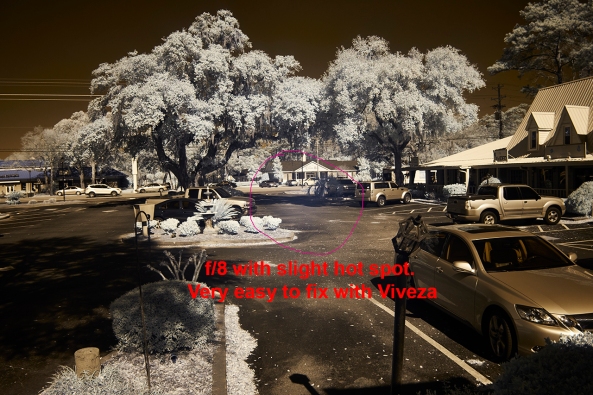
Fujifilm XF 18mm F2.0 Lens at f/8

Fujifilm XF 18mm F2.0 Lens at f/11
Voigtlander Ultra Wide-Heliar 12mm f/5.6
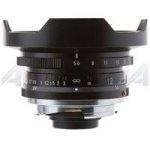
Voitlander 12mm
Another great lens from Voigtlander. This one has a built in lens hood and while it will take screw in filters they need to be wide angle versions. It also has that super smooth focusing feel but since it is so ultra wide at 12mm you can focus it pretty much at infinity and it will always be in focus. I love this lens on the X Pro 1 and X-E1. For 720nm Infrared, it works great until you hit f/22 then it gives a faint hot spot. This is just fine with me as I rarely go beyond f/11 or f/16.
Take a look at the samples:
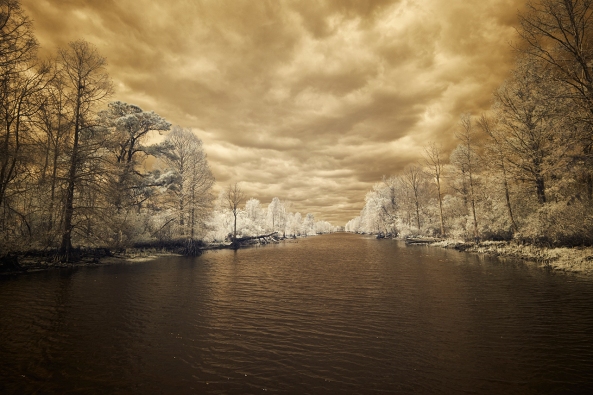
Voigtlander Ultra Wide-Heliar 12mm f/5.6 at f/8 RAW
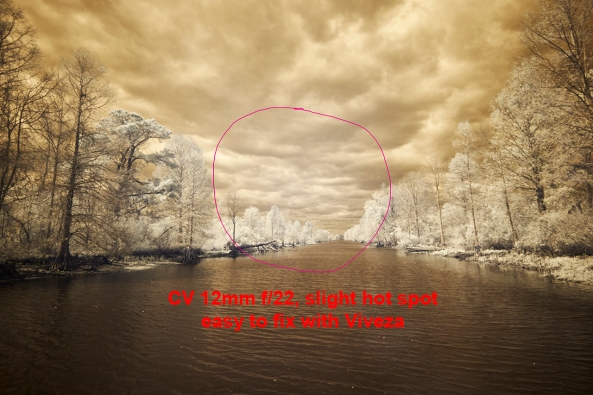
Voigtlander Ultra Wide-Heliar 12mm f/5.6 at f/22 RAW with hot spot
Fujifilm XF 18-55mm F2.8-4.0 Lens Zoom Lens:
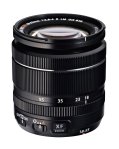
Fuji 18-55
This lens is such a disappointment to me… It is without a doubt my favorite walk around Fuji lens on the X-E1 camera. I hardly ever take it off. Sharp and clear with great contrast. That being said it is all but USELESS for Infrared! There is a major hot spot problem at ALL focal lengths at ANY aperture past f/4. At f/4 it did take nice images but as you understand, useless for landscapes. Bummer….. I am beyond disappointed over this one.
Fujifilm XF 60mm F2.4 Macro Lens:
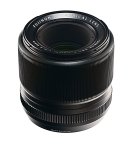
Fuji 60mm
I am going to initially tell you to simply forget this lens for Infrared. It has a seriously bad hot spot at all apertures. I will also share with you that I might actually have a bad copy of it. It gives a terrible hot spot on my X-E1 when shooting in color as well, especially when using a flash. I think that I am going to send it back to Fuji for repair and see what they think. Depending upon that I might re-evaluate it for Infrared later on!
Ok this is all for the initial post.
The next post will focus on post procseeing and what can be acheived artistically with this new Infrared Fuji X Pro 1!
Please let me know what you think!

There are many companies that make the IR conversion, how did you decide on MaxMax? Thinking of converting my XPro.
Max Max uses a really nice 720nm filter on the X Pro 1 camera that I liked better then those done by other companies. For me it was worth the cost at the time.
Hi Mark,
I love ir photography and I’m curious about the fuji x cameras… I’ve already a canon 5d converted ir but I was thinking for something lighter (here’s some of my shoots https://www.facebook.com/media/set/?set=a.426363827399437.90279.148130815222741&type=1) … I want to ask if the evf works well with ir filters (for full spectrum modification) or the ovf is the only one suitable. Also , does the af need calibration ?
Greetings
Giovanni, your work looks very good! As for the Fuji, the EVF works great! Calibration is a non issue as the camera is mirror-less and uses contrast focus. It will focus fine! I have had several full spectrum conversions and found that I mostly used 590nm or 630nm external filters. Now I have a 720nm conversion on the Fuji X Pro 1 now and am loving it very much. I might retire my GH2 590nm conversion!
Hi Mark,
Just converted one of these the other day, and saw you were interested in the transmission of the original and went ahead and measured the transmission curve. You can find the curve at http://kolarivision.com/internalcutfiltertransmission.html
For the best color results, you can use a CC1 filter or one of our hotmirrors, paired with a strong UV Haze filter, or our internal two spectrum conversion. The 486 is close, but still lets in a little too much UV.
Best regards,
Ilija
Llija, thanks for the comment. Your company was recently brought to my attention by one of your very satisfied customers. I did visit your site and found it both interesting and educational. For my next conversion I will give you guys a try. Understand, I work at this full time and run many workshops/excursions every year, in fact I just got back from 2013s first IR workshop in Charleston, SC today. I recommend conversion and filter companies to my students as well as to my readers to my 2 educational blogs all of the time.
Are you willing to give a slight price discount under my name to customers sent to you thru my blogs and workshops? Are you able to send literature for hand out? I can add you to my list of recommended suppliers but your customers results and communications records perfect. I understand that sometimes things go bad and complaints are a hazard of the life, but a negative track record of customer complaints would force removal of your company. I cannot imagine any reason for this based on the feed back your customers are giving me on you all!
If we were to assist you in customer generation I would expect you to add me to your web site as one of your pro users with images as well as links back to the blogs.
I think that a relationship between our 2 companies would help the future of IR photography/conversions/education! I can provide you with a schedule of the currently planned IR workshops that we have planned for the year as well.
I can see that I am going to need a camera converted by you for testing and use. Perhaps something in the 800nm range. I have had so many conversions over the years (15 so far) and have only kept the following:
Canon 20D 590nm as a student loaner camera
Canon 10D 850nm as a student loaner camera
Panasonic GH2 590nm (which I use randomly but is now a student loaner camera
Fuji X Pro 1 720nm (my main IR camera)
I could see something like a 800nm canon G series, or perhaps another full spectrum conversion in some point and shoot. I will think on this for a week or so then purchase one and sent it out to you all for conversion.
Please let me know if you are interested in a partnership with us. We have a retail location here in Pawleys Island and have about 6 major workshops/excursions a year and perhaps 10 1day seminars over the year as well for special interest groups.
http://www.markhilliardatelier.wordpress.com
http://www.infraredatelier.wordpress.com
http://www.thelensworkgallery.com
Mark Hilliard, Infrared Photography Specialist
The Lens Work Gallery
10744 Ocean Hwy, Unit H1
Pawleys Island, SC 29585
843-267-2700
Mark,
I would definitely be interested in a partnership!
If you look around you will find a very good track record of happy customers!
There are some reviews below, and more on various forums.
http://feedback.ebay.com/ws/eBayISAPI.dll?ViewFeedback2&userid=kolari_vision_llc&ftab=AllFeedback
http://kolarivision.com/testimonials.html
You will find that we have low prices to begin with, at half the price or less of the other companies for many models, with free shipping and other benefits that cost extra at the other places. Our margins are small to keep the prices low, but I will see what kind of discount I can provide. I would be happy to feature you on our site and put up links to relevant pages here!
Shall we discuss more details through email? You can reach me at kolarivision@gmail.com
Mark, nice to see a new camera like the Fuji Xpro being converted and reviewed. However, as most of your readers may already have camera systems of their own such as I have with Micro Four Thirds, it would be of interest to compare the Fuji to to some of the systems that you have used to see what the benefits are, especially given the rather high cost of the Fuji and the conversion. I would be very interested to see how it compares with the Olympus and Lumix models such as the EPL1 and GH2 that you have raved about in the recent past. Given my investment in three converted M4/3 cameras, plus three standard others, it would be of great interest to know if the Fuji system is a quantum leap above these or just a modest or maybe just a neutral advantage.
John, the X Pro 1 is much better than any of the EP series of Oly micro 4/3 systems that I have converted. It is sharper than my Canon 5D conversion. The only other CURRENT camera that I have that comes close to it is the Panasonic GH2 590nm IR. There is just something about the X Pro 1 system…. It not only takes me back to a better time but creates batter images as well… IT was expensive but I have already found another conversion company that does it for around $300.00 I have also been told that the Fuji X 14mm lens works great in IR!
Congratulations for your new IR camera. 🙂
And thanks for the post and the samples.
The only “wrong” think I think is the conversion price. I have mentioned you before of a company named KolariVision (www.kolarivision.com), where I do my conversions. The guy also can convert X-Pro1 and the price is no more than $300. Otherwise the regular price is $250.
In fact I was talking with him few weeks ago and he told me for the X-trans sensor camera conversions, but I already have my NEX-7 converted. You may check with him in the future. I am extremely satisfied with every conversion he did for me.
I wish you to have fun with your “new” IR camera and can’t wait to see more pictures from it.
Cheers!
I do not recall this conversion company. Do you have any info on them like contact names and web site? I can add them to my vendor list for others as well! Of the 3 main converters out there, LDP, Lifepixel and Spencers Camera, only LDP currently does the conversion. I am always on the search for other good companies. Where is this one located?
Oops, you DID include the URL!
We were talking once about hot mirror setups. That’s when we exchanged messages as I shared that I have bought a hotmirror filter from Kolari vision.
Now they even have visible + IR (blocks only UV). I have my camera converted to that now, as I realized with the time that UV photography is quite challenging and requires special lenses.
I highly recommend KolariVision! Contact the guy – the e-mail is at the contacts page. I have converted several cameras there and have bought many filters. Only positives so far. They have a customers page with images from their customers. Quite nice.
How is the Fuji? Do you have any gallery/website where you put your personal photography? I really would like to see your work!
Thanks for the nice post again.
Thanks for the information! i will check these guy out.
The Fuji is pure joy! You can see “a lot” of my images under the galleries tab on the top of:
I just got back my X-Pro 1 from Kolari Vision where I had it converted for full spectrum. The support and technical knowledge is great from Kolari Vision.
Here is a set on Flickr of the IR images from the camera using an R72 filter:
.
My 60mm Fuji lens has the same bad hot spot at all apertures in IR as well I don’t consider it very usable.
The 14mm fuji lens has no hot spot at any aperture 🙂
My Samyang 8mm fisheye seems to be okay as well not showing any hot spots with my homemade IR gel filter but I’ll try it in a couple of weeks with a glass 665mn IR filter and see for sure.
Cheers
Mark, I really enjoyed this. It makes me want to get back to doing infrared again.